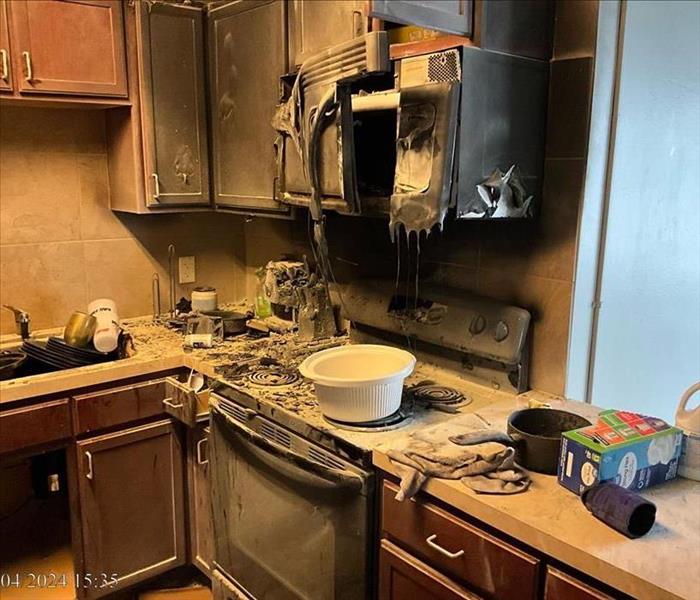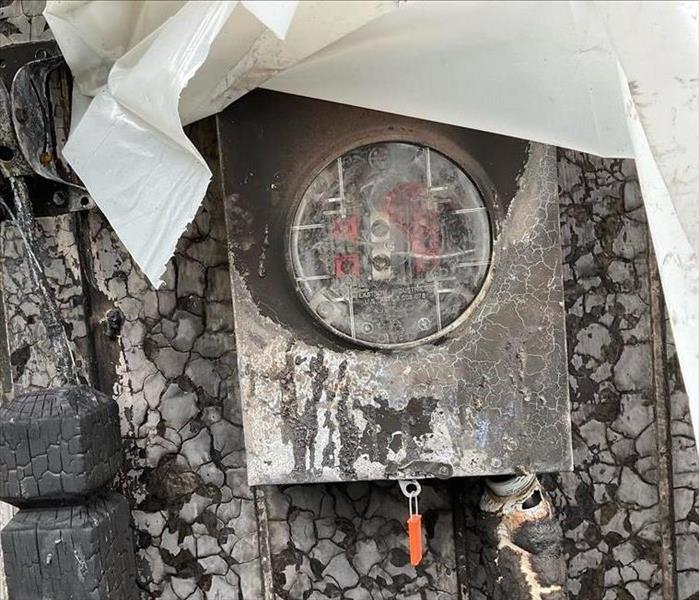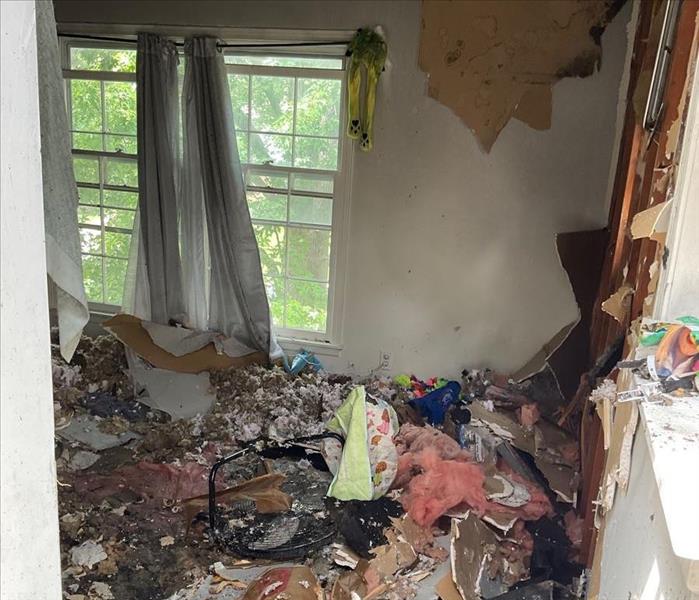Recent Fire Damage Posts
How to Identify Fire Damage Beyond the Obvious: Tips on spotting hidden fire damage in a property
7/29/2024 (Permalink)
 Microwave fire in a residence.
Microwave fire in a residence.
Experiencing a fire can be devastating, and the aftermath often leaves property owners focused on the visible damage—charred walls, burnt furniture, and scorched belongings. However, fire damage can extend far beyond what the eye can see. Hidden fire damage can pose serious risks to the structural integrity of your property and the health of its occupants. Identifying these less obvious signs is crucial for effective restoration and safety. Here are some tips on spotting hidden fire damage in your property.
1. Inspect Electrical Systems
Fires can cause significant damage to electrical wiring and systems, which might not be immediately visible. Signs to look for include:
- Flickering Lights: If your lights flicker or dim without a clear cause, it might indicate damage to the electrical wiring.
- Burnt Odors: Persistent burnt smells near outlets or switches could signify hidden electrical damage.
- Malfunctioning Appliances: Appliances that suddenly stop working or behave erratically might be connected to fire-damaged wiring.
2. Check for Structural Damage
Fire can weaken the structural elements of a building, even if they appear intact at first glance. Pay close attention to:
- Warped or Discolored Walls and Ceilings: Heat can cause walls and ceilings to warp or discolor. This damage might not be immediately obvious but can indicate deeper issues.
- Sagging Floors or Roofs: Fire can damage the support beams, causing floors and roofs to sag or feel unstable.
- Cracked or Soot-Stained Surfaces: Cracks in the walls or soot stains in unexpected areas can point to hidden fire damage.
3. Examine HVAC Systems
Heating, ventilation, and air conditioning (HVAC) systems can harbor hidden fire damage. Signs to watch for include:
- Smoke Odor from Vents: If you notice a smoke smell coming from your vents, it could mean that soot and smoke have infiltrated the ductwork.
- Reduced Air Quality: Poor indoor air quality, including increased dust or respiratory issues among occupants, can indicate contaminated HVAC systems.
4. Look for Water Damage
Water used to extinguish the fire can cause its own set of problems, often hidden behind walls or under floors. Signs of water damage include:
- Mold Growth: Mold can start growing within 24-48 hours of water exposure. Check for mold in areas that were sprayed with water during firefighting efforts.
- Staining and Bubbling: Water stains, bubbling paint, or peeling wallpaper can indicate water damage beneath the surface.
- Musty Odors: Persistent musty smells can signal hidden water damage and mold growth.
5. Assess Smoke and Soot Damage
Smoke and soot can penetrate deeply into materials, leaving behind damage that isn't immediately visible. To identify hidden smoke and soot damage:
- Smell for Persistent Odors: Lingering smoke smells can indicate that soot has penetrated deep into materials like carpets, drapes, and furniture.
- Test Surfaces: Wipe surfaces with a white cloth to check for soot residue. Even if surfaces appear clean, they might still harbor soot.
- Check Insulation: Smoke can infiltrate insulation materials, which might need to be replaced even if they don't appear damaged.
6. Inspect Plumbing
The heat from a fire can damage plumbing pipes, leading to hidden leaks or other issues. Look for:
- Discolored Water: If your water appears discolored, it could be a sign that fire-damaged pipes are corroding.
- Reduced Water Pressure: Low water pressure might indicate leaks or blockages in the plumbing caused by fire damage.
- Water Stains: Look for water stains on walls, ceilings, and floors that could indicate hidden leaks.
Conclusion
Identifying hidden fire damage is crucial for ensuring the safety and integrity of your property. While some signs might be subtle, paying attention to changes in your home’s appearance, functionality, and odors can help you detect these hidden dangers. For a thorough and professional assessment, consider contacting fire damage restoration experts like SERVPRO of Downtown Kansas City. Our trained technicians have the expertise and equipment to uncover and address hidden fire damage, ensuring your property is fully restored and safe for occupancy.
If you've experienced a fire and need professional assistance, don't hesitate to reach out to SERVPRO of Downtown Kansas City. We are here to help you every step of the way, from initial assessment to complete restoration.
Mold Prevention Tips for Protecting Your Property Post-Fire
4/17/2024 (Permalink)
 If you need assistance with fire and mold remediation don't hesitate to reach out to the experts at SERVPRO of Downtown Kansas City.
If you need assistance with fire and mold remediation don't hesitate to reach out to the experts at SERVPRO of Downtown Kansas City.
Experiencing a fire in your home or business is a traumatic event, but the challenges don't end once the flames are extinguished. In addition to the immediate damage caused by the fire, there is also the risk of mold growth in the aftermath. Mold thrives in damp, humid environments, making properties that have suffered water damage from firefighting efforts particularly susceptible. To help you limit mold growth after a fire, we've compiled some essential tips to protect your property and promote a safe, healthy environment for you and your family or employees.
Prompt Water Damage Mitigation
The first step in preventing mold growth after a fire is to address any water damage quickly. Water from firefighting efforts can seep into building materials and create the ideal conditions for mold growth. Work with a professional restoration company like SERVPRO® to thoroughly dry out your property and mitigate water damage to limit mold from taking hold.
Thorough Cleaning and Disinfection
After a fire, it's essential to thoroughly clean and disinfect your property to remove soot, ash, and other fire-related residues. These residues can provide nutrients for mold growth and must be removed to help prevent mold from proliferating. Professional cleaning services can ensure that your property is thoroughly cleaned and sanitized to minimize the risk of mold growth.
Proper Ventilation
Adequate ventilation is crucial for preventing mold growth in the aftermath of a fire. Proper airflow helps to dry out damp areas and reduce humidity levels, making it less conducive for mold to thrive. Open windows and doors when possible, and use fans or dehumidifiers to promote air circulation and moisture removal.
Inspect and Repair Leaks
Even small leaks can create opportunities for mold growth, so it's essential to inspect your property for any signs of water intrusion. Check for leaking pipes, roof leaks, or damaged seals around windows and doors. Promptly repair any leaks or water damage to help prevent mold from taking hold.
Monitor Moisture Levels
Regularly monitor moisture levels in your property, especially in areas prone to dampness such as basements, crawl spaces, and bathrooms. Invest in a moisture meter to measure humidity levels and address any areas of concern promptly. Keeping moisture levels in check is key to preventing mold growth in the aftermath of a fire.
In conclusion, preventing mold growth after a fire requires proactive measures to address water damage, clean and disinfect your property, promote proper ventilation, inspect and repair leaks, and monitor moisture levels. By taking these steps, you can help protect your property from the devastating effects of mold and promote a safe, healthy environment for yourself and your loved ones or employees. If you need assistance with mold prevention or remediation after a fire, don't hesitate to reach out to the experts at SERVPRO of Downtown Kansas City for professional assistance.
Restoring Fire-Damaged HVAC Systems
12/13/2023 (Permalink)
 At SERVPRO® of Downtown Kansas City, we have the expertise and experience to handle the complexities of fire damage restoration.
At SERVPRO® of Downtown Kansas City, we have the expertise and experience to handle the complexities of fire damage restoration.
A fire in your home or business is a distressing experience. While the immediate damage from flames and smoke is evident, one often overlooked aspect is the impact on your HVAC system. Fire-damaged HVAC systems can pose both safety and operational risks, making it essential to address them promptly. In this blog, we'll explore the significance of restoring fire-damaged HVAC systems, the risks involved, and the steps to take to bring back comfort and safety to your space.
Understanding the Impact of Fire on HVAC Systems
Fires can affect HVAC systems in multiple ways:
Direct Damage: The intense heat of a fire can melt or warp components of the HVAC system, rendering it inoperable.
Smoke and Soot: Smoke and soot can infiltrate the HVAC ducts, contaminating the entire system. This not only affects air quality but can lead to foul odors and further damage.
Water Damage: The water used to extinguish the fire can infiltrate HVAC components, causing corrosion and electrical issues.
Risks of Neglecting Fire-Damaged HVAC Systems
Neglecting fire-damaged HVAC systems can have serious consequences:
Safety Concerns: Damaged electrical components may pose a fire hazard or risk of electrical shock.
Air Quality: Contaminated HVAC systems can spread smoke and soot throughout the building, compromising indoor air quality and affecting the health of occupants.
Operational Efficiency: Inoperable HVAC systems can disrupt the comfort and functionality of your space.
Steps to Restore Fire-Damaged HVAC Systems
- Before assessing or attempting any restoration, ensure the area is safe to enter. Professionals should handle any electrical or structural concerns.
- Engage a certified HVAC technician to assess the extent of the damage. They will evaluate the components and the ductwork for damage, and recommend the best course of action.
- A thorough cleaning and decontamination process is crucial to remove smoke, soot, and odors from the system. Professional restoration services, like SERVPRO®, have the expertise and equipment for this task.
- Depending on the assessment, the technician will repair or replace damaged components. This may involve fixing or replacing ductwork, fans, or electrical elements.
- After repairs, the HVAC system needs to be thoroughly tested and balanced to ensure it functions efficiently and safely.
- It's essential to conduct air quality testing to ensure that the system is not circulating contaminants throughout the building. This step guarantees a safe and healthy indoor environment.
Restoring fire-damaged HVAC systems is a crucial aspect of fire damage recovery that should not be overlooked. Neglecting the impact on your HVAC system can compromise safety, indoor air quality, and operational efficiency. If you've experienced a fire-related incident, it's essential to engage professionals to assess and restore your HVAC system. At SERVPRO® of Downtown Kansas City, we have the expertise and experience to handle the complexities of fire damage restoration, including HVAC systems. Our priority is your safety, comfort, and peace of mind!
How Fire Restoration Experts Bring Your Property Back to Life
8/16/2023 (Permalink)
Experiencing a fire at your home or property can be one of the most distressing and devastating events. Beyond the immediate impact of the flames, the aftermath of fire damage can leave you feeling overwhelmed and uncertain about the next steps. However, there is hope. Fire damage restoration experts are skilled professionals who can breathe new life into your property, helping you rebuild and recover after the devastation. In this blog, we'll explore how restoration experts, such as our SERVPRO of Downtown Kansas City team, works their magic, bringing your property back to life after a fire, and guiding you through the journey of restoration and renewal.
Immediate Response and Assessment
After the fire is extinguished and the property is deemed safe to enter, restoration experts promptly respond to assess the extent of the damage. Their trained eyes can identify areas that require immediate attention, such as structural integrity, water damage, and potential safety hazards.
Comprehensive Damage Evaluation
Fire damage can be multifaceted, encompassing not only visible destruction from flames but also hidden issues like smoke, soot, and water damage. Restoration experts conduct a thorough evaluation to understand the full scope of the damage and devise a comprehensive restoration plan.
Safeguarding Unaffected Areas
During the restoration process, experts take steps to protect any areas of your property that remain unaffected by the fire. This precautionary measure helps prevent further damage and ensures that the restoration work is focused on the areas that truly need attention.
Professional Cleaning and Deodorization
One of the most significant challenges after a fire is the pervasive smell of smoke. Restoration experts utilize advanced cleaning techniques and powerful deodorization methods to remove soot and lingering odors, leaving your property fresh and clean.
Water Damage Restoration
In many cases, fire extinguishing efforts can lead to water damage. Restoration experts address waterlogged areas, thoroughly drying and dehumidifying them to prevent mold growth and further structural issues.
Content Restoration
Your personal belongings can hold significant sentimental value. Restoration experts carefully clean, restore, and salvage as many possessions as possible, minimizing losses and preserving cherished items.
Structural Repairs and Reconstruction
From minor repairs to major structural reconstructions, restoration experts have the expertise to restore your property to its pre-fire condition. They work diligently to ensure the safety and stability of the building.
Handling Insurance Claims
Navigating insurance claims can be overwhelming, especially during a challenging time like post-fire restoration. Restoration experts can assist you in documenting the damage, providing accurate assessments, and working with your insurance provider for a smoother claims process.
Fire damage may leave you feeling defeated, but restoration experts, such as our SERVPRO of Downtown Kansas City team, are your partners in breathing new life into your property. Their skill, knowledge, and dedication enable them to tackle the complexities of fire damage, helping you rebuild and recover after the ordeal. With their expertise, your property can rise from the ashes, rejuvenated and restored, ready to embrace a new chapter of life. Remember, the path to restoration may be challenging, but with restoration experts by your side, your property will be brought back to life, embodying the strength of resilience and the promise of renewal.
Protect Your Home: Friendly Fire Prevention Tips
7/5/2023 (Permalink)
Keeping your home safe from fires is crucial for the well-being of your family and the preservation of your property. By taking a proactive approach and implementing fire prevention measures, you can significantly reduce the risk of a devastating fire. In this article, we'll provide you with some tips to help prevent a home fire and ensure the safety of your loved ones.
Install Smoke Alarms: Place smoke alarms on every level of your home, including inside bedrooms and outside sleeping areas. Test them monthly and replace the batteries at least once a year. Smoke alarms are essential for early detection, giving you and your family precious time to escape in case of a fire.
Create a Fire Escape Plan: Develop a detailed fire escape plan and practice it regularly with your family. Identify two exit routes from every room and establish a meeting point outside your home. Teach everyone how to stay low to avoid smoke inhalation and emphasize the importance of not returning inside once they have evacuated.
Practice Safe Cooking: Never leave cooking unattended, especially when using stovetops or ovens. Keep flammable items, such as potholders, towels, and curtains, away from heat sources. If a cooking fire occurs, use a lid to smother the flames or a fire extinguisher specifically designed for kitchen fires. Do not use water to extinguish grease fires.
Be Mindful of Electrical Safety: Avoid overloading electrical outlets and using damaged cords or appliances. Unplug electrical devices when not in use, especially before going to bed. Routinely inspect your electrical system for signs of wear, such as flickering lights or discolored outlets, and have any issues addressed by a qualified electrician.
Practice Responsible Candle Usage: Keep candles at least one foot away from anything flammable and always extinguish them before leaving the room or going to bed. Consider using flameless LED candles as a safer alternative. Remember, a moment of carelessness with a candle can lead to a devastating fire.
Properly Maintain Heating Systems: Ensure that your heating systems, such as furnaces, fireplaces, and space heaters, are well-maintained and cleaned regularly. Keep flammable materials, such as furniture and curtains, a safe distance away from heat sources. Never leave space heaters unattended or use them while you sleep.
Store Flammable Materials Safely: Store flammable liquids, such as gasoline, propane, and paint thinners, in approved containers and in a well-ventilated area away from ignition sources. Properly seal and store them outside your home, following local safety regulations.
In the unfortunate event that a fire does occur, remember that you're not alone in the recovery process. SERVPRO of Downtown Kansas City is here to support you. Our dedicated team of fire restoration professionals will respond quickly to assess the damage and provide comprehensive restoration services. From cleaning up soot and smoke residue to repairing structural damage, we're committed to helping you get your home back in order as soon as possible.
Preventing a home fire requires a combination of awareness, responsibility, and regular maintenance. By following these friendly fire prevention tips, you can significantly reduce the risk of a fire in your home and ensure the safety of your loved ones. However, if disaster strikes, trust SERVPRO of Downtown Kansas City to provide the expertise and support you need to recover and rebuild. Remember, we're just a phone call away when you need us most!



 24/7 Emergency Service
24/7 Emergency Service


